|
PAINTED TURTLES REVISITED The climate in York SC is moderate enough that even on some mid-winter days we spy turtles sunning along the banks of Hilton Pond or on logs floating on its surface. Most of the year these shelled creatures are out of sight, patrolling the muddy pond bottom in pursuit of some tasty morsel of food. Come June, however, there's an inevitable flurry of activity when members of our four-species aquatic turtle population--Painted Turtles, Yellowbelly Sliders, Eastern Mud Turtles, and Common Snapping Turtles--become temporarily terrestrial as gravid females seek dry land on which to deposit eggs. Such was the case this week when we spotted several female turtles exploring small grassy plots around the Center's old farmhouse. More surprisingly, a male Painted Turtle was ambling along on terra firma. We have no idea why HE left the cozy confines of Hilton Pond--because turtles mate in the water, his copulatory duties were undoubtedly complete--so we don't often encounter adult males on land. Thus, we took the opportunity to make a few photos of this wayward individual and to revisit the topic of Painted Turtles.
All text & photos © Hilton Pond Center We try not to interact with turtles when they come ashore in June because we discovered a human presence can have unintended consequences. Several years back we encountered a female Painted Turtle preparing to lay eggs, so we moved in close to take photos. We fired off a few exposures and then retreated to our office, from which we watched the turtle abandon her nest-digging efforts and wander back toward Hilton Pond--still laden with eggs. Since then we've noticed females are particularly alert to unusual movement while nest-digging, so we're careful to stay away at such times.
All text & photos © Hilton Pond Center The male Painted Turtle we saw this week was a different matter. While this animal made his way across the backyard we looked at him through binoculars and knew he definitely was NOT a female; even from a distance we could see his front feet were armed with long, sharp claws the male uses to stroke the nose of a female during the mating ritual. Because turtles are well-armored with shells and scaly skin, we suppose the female's nose is about the only place a male could touch to get her attention.
All text & photos © Hilton Pond Center By comparison to the male's front claws a female's are quite short, but those on her HIND legs are long--all the better to excavate a nest in hard-packed soil. As might be expected, the male's hind claws are short--he has nothing to do with nest building. As shown in several photos on this page, a Painted Turtle is able to pull each of its four walking appendages inside the shell when threatened; even the tail (above) folds into a space between its two short-clawed hind legs.
All text & photos © Hilton Pond Center It might just be easier to say ALL a Painted Turtle's appendages can be withdrawn--even the head (above), which slides straight back into the shell and illustrates where the term "turtleneck" comes from. We should note that--unlike the shell of the Eastern Box Turtle--the Painted Turtle's external structure provides only partial protection from the environment and potential predators. Box turtles pull in their appendages and then--thanks to a hinge on the plastron (lower shell)--can shut themselves in, tightly and completely. This hinge is absent in Painted Turtles (below left), so a persistent predator with a narrow snout or long claws can still get at their legs and tails.
All text & photos © Hilton Pond Center Like its plastron, the Painted Turtle's carapace (above right) consists of large bony plates, each covered by a translucent, wafer-thin, pigmented scale. The plates are fused together, forming a stiff but portable shelter. The scales protect the plates from excessive abrasion as the turtle glides across land or the pond bottom, although a strong impact can dent the carapace and leave permanent marks as shown above right. Occasionally we have found living Painted Turtles with significant scratches on their shells where a turtle-catching dog bit down hard.
All text & photos © Hilton Pond Center The lateral view (above) shows the Painted Turtle's shell has a rather low profile--much flatter than that of the Eastern Box Turtle or most of the other freshwater turtles. We speculate this flatness allows Painted Turtles to slide into nooks and crannies on a pond bottom that are inaccessible to turtles with more rounded shells. The carapace of the female Painted Turtle is somewhat less-flattened than that of the male, the better to allow space for developing eggs.
All text & photos © Hilton Pond Center Unlike the rest of their reptilian relatives--snakes, lizards, crocodilians, and the enigmatic lizard-like Tuatara of New Zealand--turtles have no teeth and rely upon a sharp-edged beak to tear prey items into bite-sized pieces. Many North American turtles have a slightly hooked tip to the beak--some have a notch instead--but Painted Turtles bear two tooth-like cusps (above) that serve the same function as incisors. These cusps differentiate Painted Turtles, Chrysemys picta, from other basking turtles in the Carolinas, including all cooters and sliders (Pseudemys spp.).
All text & photos © Hilton Pond Center As we were writing this installment of "This Week at Hilton Pond," we gazed out the office window for inspiration and experienced an interesting case of serendipity: A female Painted Turtle had wandered into view and stopped at a patch of bare ground about 15 feet away. Something about this microhabitat caught her attention as a possible nest site, so she began urinating to soften the packed earth. Within a few minutes her hind legs were churning--in slow motion, of course--as she scraped away soil with her claws. For more than a hour she dug, pausing occasionally to rest before digging some more. Eventually she stopped and tilted up the anterior end of her shell; we're guessing she was laying eggs at this point. After a few minutes in this posture the turtle lowered her shell and her hind legs again went into action filling in the nest hole and covering her eggs with dirt. Finally, for about 15 minutes she slid back and forth in rhythmic fashion, smoothing over her excavation before heading back toward Hilton Pond. The whole procedure took a little more than two hours, during which time we used our telephoto lens to snap a few photos--hopeful our staying some distance away would not alarm the turtle. After this Painted Turtle female departed, we went out to examine her handiwork and had a difficult time finding the spot where she had made her nest. This, was exactly what she had intended: To make the nest site inconspicuous to the eye. For this particular nest we decided to thwart the 'coons by covering the spot with wire mesh weighted down by a chunk of concrete. It's not that we were trying to interfere with nature or the Raccoons' diet; we just want to see what happens if these particular eggs are left to hatch. In a month--after summer rains have washed away the scent of the mother turtle--we'll remove the mesh. Turtle eggs usually take about 60 days to hatch, so come late August we may be revisiting the topic of Painted Turtles once more as several little turtlets dig their way to the surface and head toward Hilton Pond.
All text & photos © Hilton Pond Center POSTSCRIPT: The eggs laid by the Painted Turtle described above finally hatched--but MUCH later than we expected. To read about the eventual emergence of Hilton Pond Center's next crop of baby turtles, please visit Nothing's Slower Than A Turtle. Comments or questions about this week's installment?
Thanks to the following fine folks for recent gifts in support of Hilton Pond Center for Piedmont Natural History and/or Operation RubyThroat: The Hummingbird Project. Your tax-deductible contributions allow us to continue writing, photographing, and sharing "This Week at Hilton Pond." (Please see Support if you'd like to make a gift of your own.)
"This Week at Hilton Pond" is written & photographed You may wish to consult our Index of all nature topics covered since February 2000. You can also use our on-line Hilton Pond Search Engine at the bottom of this page. For a free, non-fattening, on-line subscription to |
|
Make direct donations on-line via
Network for Good: |
|
|
Use your PayPal account
to make direct donations: |
|
|
If you like to shop on-line, you please become a member of iGive, through which more than 700 on-line stores from Barnes & Noble to Lands' End will donate a percentage of your purchase price in support of Hilton Pond Center and Operation RubyThroat. For every new member who signs up and makes an on-line purchase iGive will donate an ADDITIONAL $5 to the Center. Please sign up by going to the iGive Web site; more than 150 members have signed up to help. It's a painless, important way for YOU to support our work in conservation, education, and research. |
|
| The highly coveted Operation RubyThroat T-shirt (four-color silk-screened) is made of top-quality 100% white cotton. It highlights the Operation RubyThroat logo on the front and the project's Web address (www.rubythroat.org) across the back.
Now you can wear this unique shirt AND help support Operation RubyThroat: The Hummingbird Project and Hilton Pond Center. Be sure to let us know your mailing address and adult shirt size: Small (suitable for children), Medium, Large, X-Large, or XX-Large. These quality shirts don't shrink! Price ($21.50) includes U.S. shipping. A major gift of $1,000 gets you two Special Edition T-shirts with "Major Donor" on the sleeve. |
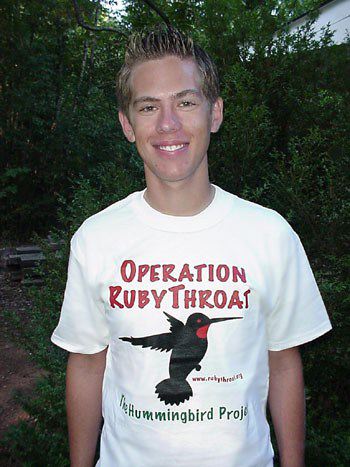
Need a Special Gift for a Want to make a If so, why not use our new handy-dandy on-line Google Checkout below to place your secure credit card order or become a Major Donor today? |
|
|
|
|
SPECIES BANDED THIS WEEK: * = New species for 2008 WEEKLY BANDING TOTAL 8 species 19 individuals YEARLY BANDING TOTAL (2008) 44 species 993 individuals 7 Ruby-throated Hummingbirds 27-YEAR BANDING GRAND TOTAL (since 28 June 1982) 124 species 51,160 individuals NOTABLE RECAPTURES THIS WEEK (with original banding date, sex, and current age) Ruby-throated Hummingbird (1) Chipping Sparrow (1) |
OTHER NATURE NOTES OF INTEREST --Last week we mentioned under this section that a severe thunderstorm had descended on Hilton Pond Center, complete with nearly simultaneous thunderclaps and lightning flashes that meant an electrical discharge had occurred in close proximity, we knew not where. While walking the trails this week we came to a place that looked like it had been dug up by something, perhaps a feral dog trying to get at an Eastern Chipmunk. However, as we examined the loose earth for additional clues, we saw a four-inch diameter tree root had been exposed. The root led back to a 60-foot-tall Loblolly Pine tree, and that tree had a big gash all the way up its trunk--a sure sign the lighting had struck it and exploded the earth away from its roots. We suspect this means curtains for the pine, but trees are amazingly resilient and this one may survive like our magnificent old White Oak that took a direct hit by lightning two summers ago. All text & photos © Hilton Pond Center |
|
|
|
(Back to Preceding Week; on to Next Week) Up to Top of Page Back to This Week at Hilton Pond Center Current Weather Conditions at Hilton Pond Center |
 You can also post questions for The Piedmont Naturalist |
Join the |
Search Engine for |
|
|
Entertainment Centers

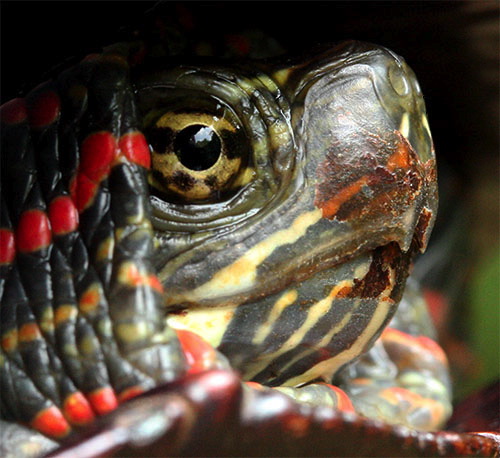
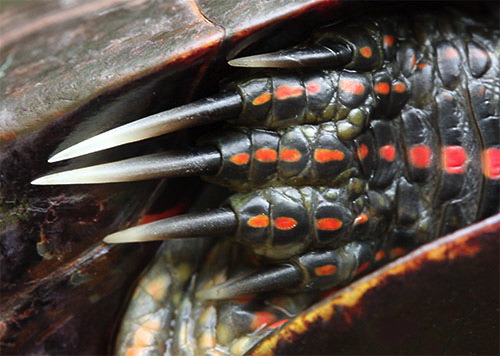
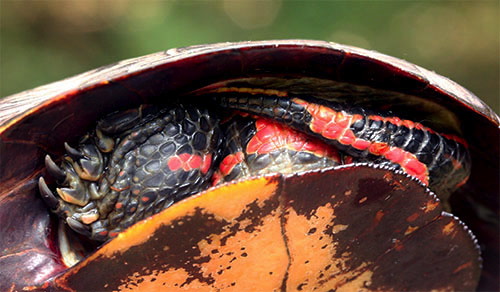
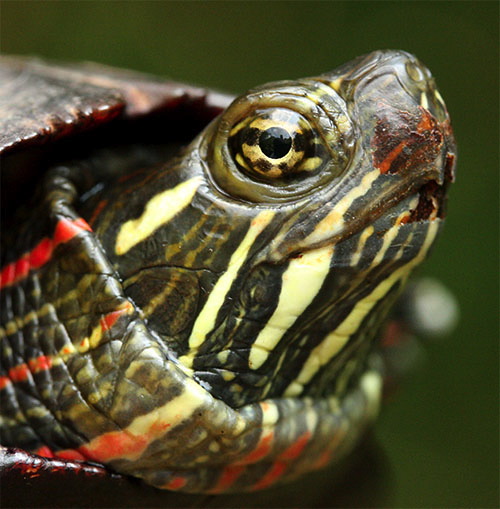
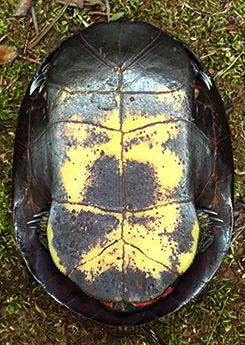
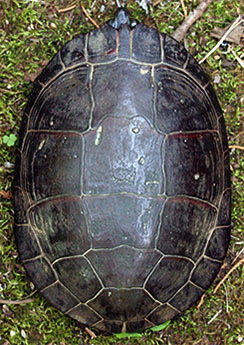
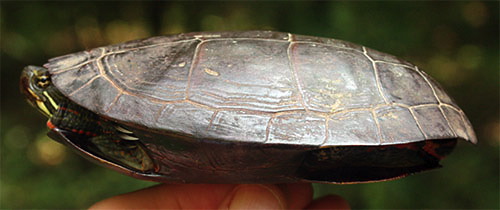
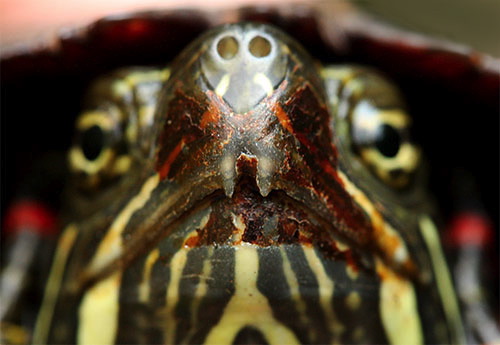
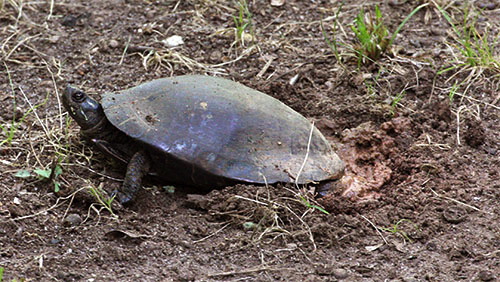
 Only a few small clods of still-moist soil enabled us to find the nest (right). The problematic thing with the Painted Turtle's egg-laying technique is that all that urine undoubtedly has odor, so a non-human animal with sharp olfactory powers probably has no trouble sniffing out a fresh turtle nest. We're sure that's what happens to most of the reproductive attempts by turtles around Hilton Pond; females lay their eggs on land and within hours some enterprising Raccoon digs them up, having scrambled eggs for supper and leaving behind an empty nest hole.
Only a few small clods of still-moist soil enabled us to find the nest (right). The problematic thing with the Painted Turtle's egg-laying technique is that all that urine undoubtedly has odor, so a non-human animal with sharp olfactory powers probably has no trouble sniffing out a fresh turtle nest. We're sure that's what happens to most of the reproductive attempts by turtles around Hilton Pond; females lay their eggs on land and within hours some enterprising Raccoon digs them up, having scrambled eggs for supper and leaving behind an empty nest hole. 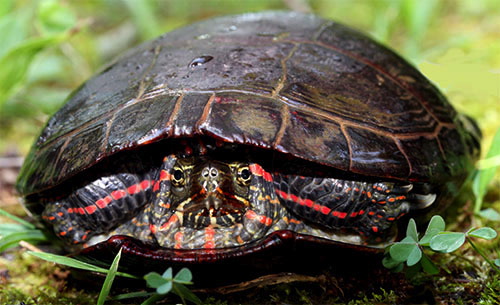


 Please report your
Please report your